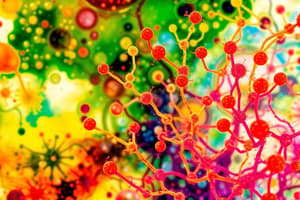Podcast
Questions and Answers
What is the primary purpose of isolation in the context of microbiology?
What is the primary purpose of isolation in the context of microbiology?
- To kill harmful microbes
- To identify the nutrients required for growth
- To separate and study characteristics of microorganisms (correct)
- To enhance the growth of microorganisms
What is the required temperature and pressure for the autoclaving technique used in sterilization?
What is the required temperature and pressure for the autoclaving technique used in sterilization?
- 100°C and 10 psi
- 150°C and 20 psi
- 200°C and 30 psi
- 121°C and 15 psi (correct)
What is the primary color of the fungal colonies observed?
What is the primary color of the fungal colonies observed?
- Brown
- White
- Greenish-yellow
- Blackish-green (correct)
Which of the following accurately describes the shape of the fungal colonies?
Which of the following accurately describes the shape of the fungal colonies?
How is the concentration of the microbial solution prepared from soil samples?
How is the concentration of the microbial solution prepared from soil samples?
Which of the following is NOT a characteristic you should observe when enumerating microbial colonies?
Which of the following is NOT a characteristic you should observe when enumerating microbial colonies?
What was the result of the bacterial colonies' shape in comparison to the fungal colonies?
What was the result of the bacterial colonies' shape in comparison to the fungal colonies?
What is the importance of using Potato Dextrose Agar in this experiment?
What is the importance of using Potato Dextrose Agar in this experiment?
What does CFU stand for when measuring microbial colonies?
What does CFU stand for when measuring microbial colonies?
Which of the following precautions is NOT mentioned for conducting the experiment?
Which of the following precautions is NOT mentioned for conducting the experiment?
Flashcards are hidden until you start studying
Study Notes
Aim of the Experiment
- Isolate and enumerate microbes (bacteria and fungi) from soil, air, and water.
Isolation Process
- Involves separating colonies of microorganisms to study characteristics like shape, size, elevation, and color.
- Sterile techniques are crucial for isolation and enumeration.
Autoclaving Technique
- Sterilization of apparatus using:
- Temperature: 121°C
- Pressure: 15 psi
- Time: 15-20 minutes
Enumeration of Microbes
- Total number of colonies calculated post-dilution.
- Colonies measured in Colony-Forming Units (CFU).
Materials Used
- High Efficiency Particulate Air Filter (HEPA).
- Nutrient Agar (NA).
- Potato Dextrose Agar (PDA).
Procedure Overview
- Sterilize materials through autoclaving.
- Prepare Petri plates with NA and PDA to solidify.
- Collect samples from:
- Air: Exposed dishes to garden and sanitary environments.
- Water: Drop-by-drop pipetting and spreading on plates.
- Soil: Sequential dilution method using sterile distilled water.
Observations of Microbial Characteristics
-
Bacterial Characteristics:
- Color: White
- Size: Small to medium, some pointed
- Shape: Predominantly round or elongated, some distorted
- Elevation: Bulging colonies
-
Fungal Characteristics:
- Color: Green and black
- Size: Generally larger colonies than bacteria
- Shape: Filamentous, with thread-like structures
Calculations and Results
- Soil Sample Calculation:
- Number of colonies in 10^(-x) dilution = y / (0.1mL) CFU
- Total colonies/mL = y x 10^x / 0.1 CFU
- Air and Water Sample Results:
- (Specific results for the water sample were not provided; water had zero colonies.)
Discussion
- Notable differences observed between fungal and bacterial colonies:
- Bacteria: White, circular, confined boundaries.
- Fungi: Blackish-green, filamentous, spreading structures.
- Potato Dextrose Agar effective for isolating fungi.
Precautions
- All operations must be in sterile conditions (hands within HEPA).
- Allow spreader to cool before use on Petri plates.
- Maintain distance of cotton plug from the burner to prevent fire.
- Change pipette after each use.
Studying That Suits You
Use AI to generate personalized quizzes and flashcards to suit your learning preferences.




